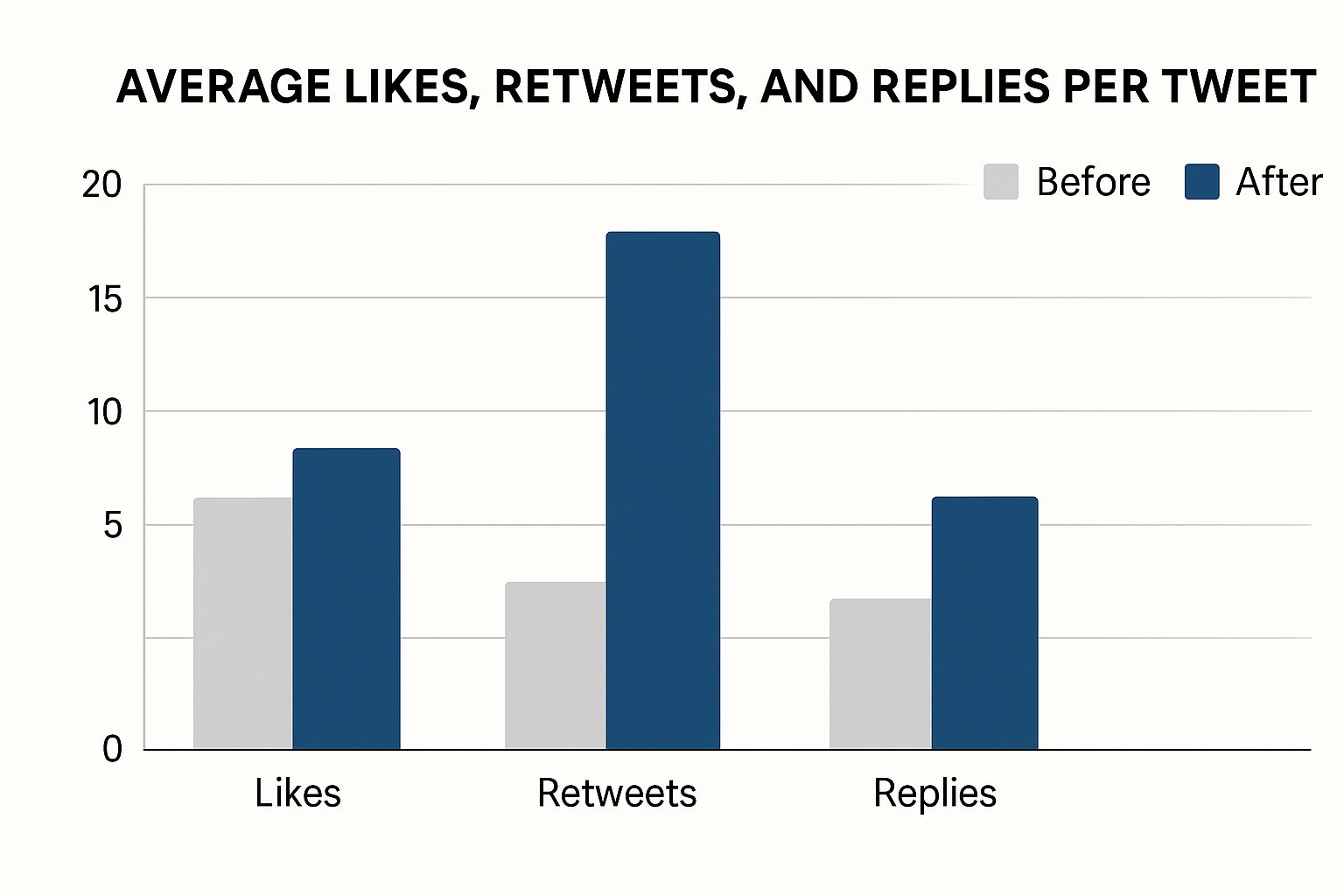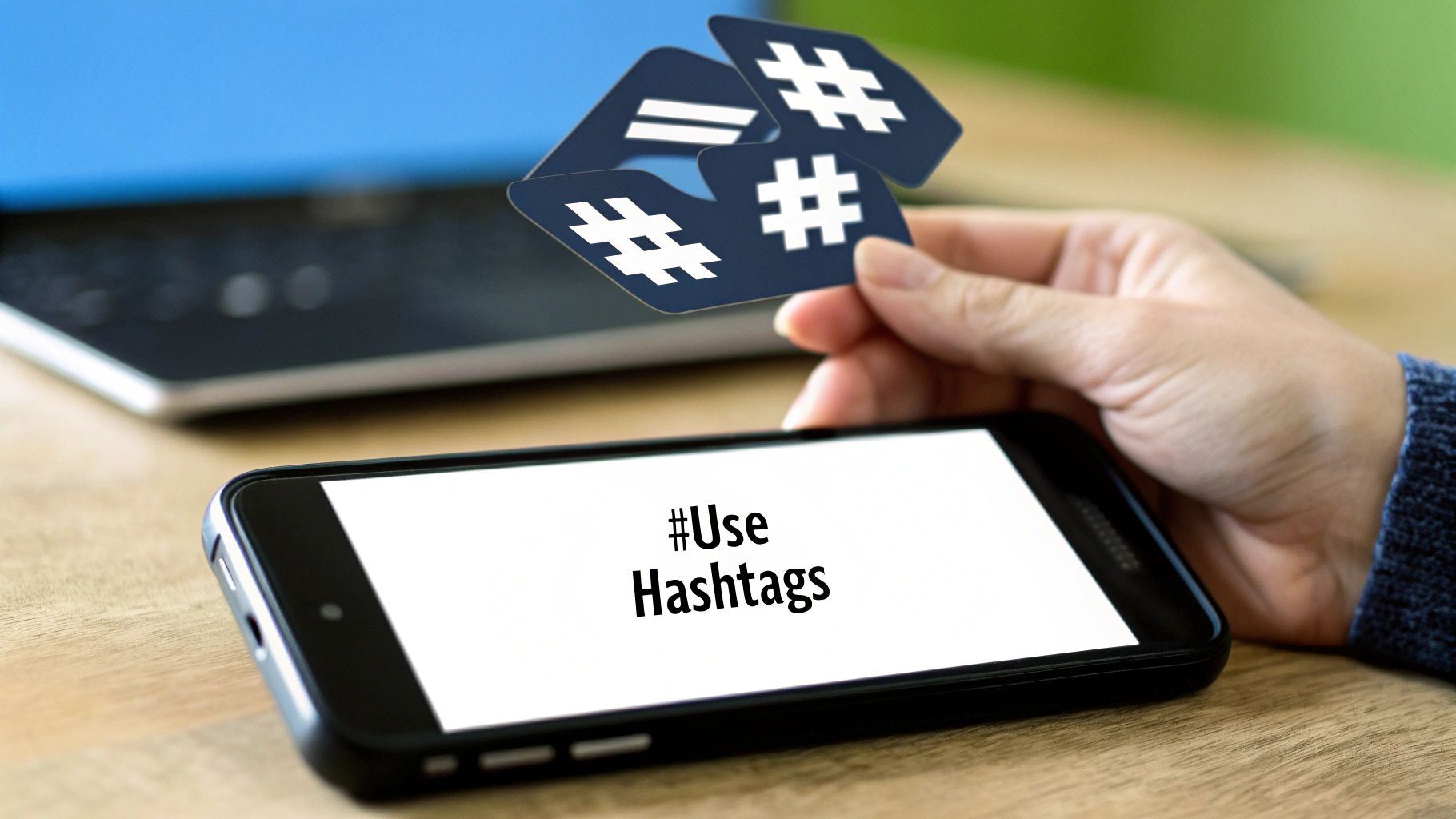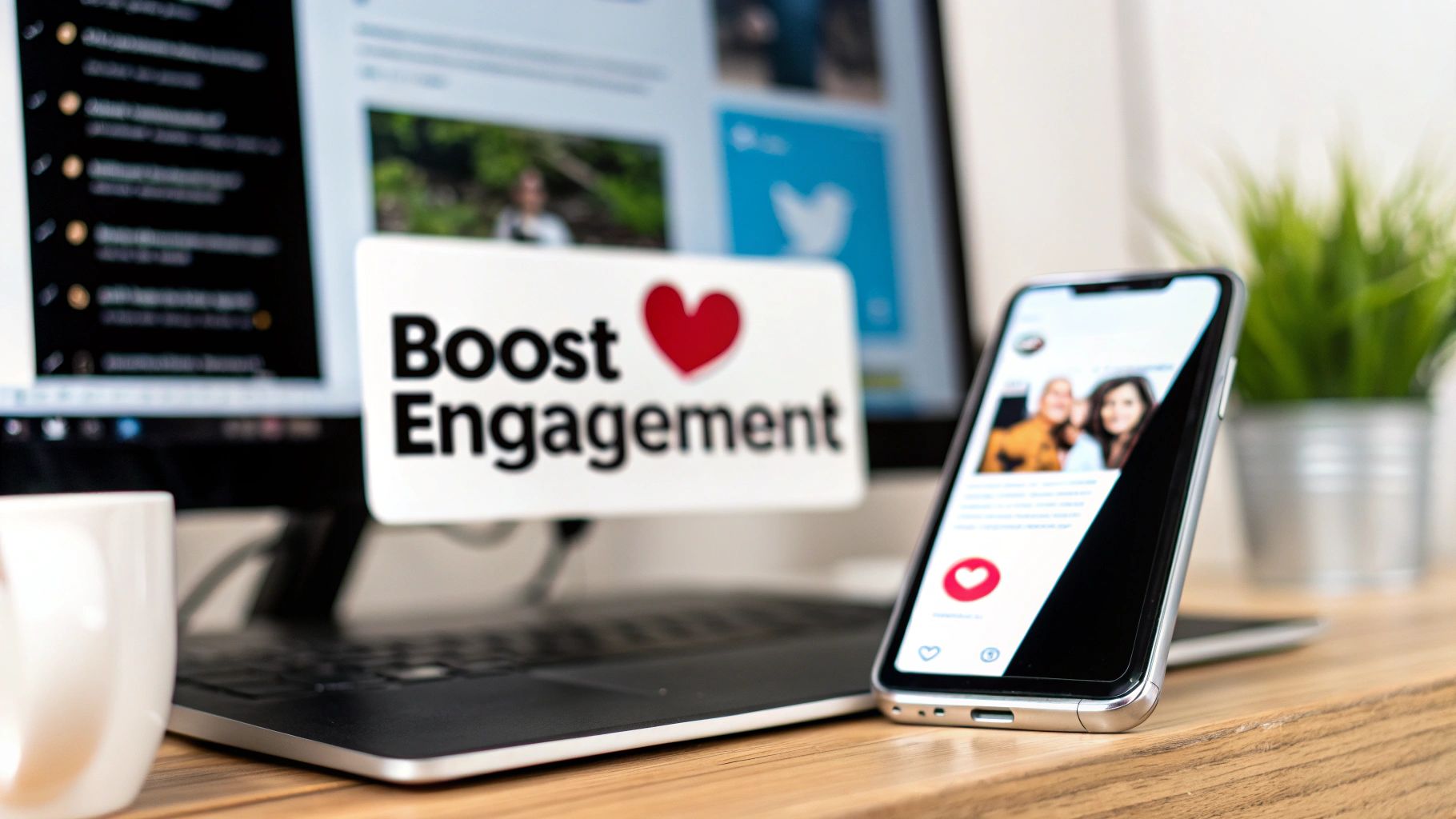Mastering Twitter Metrics That Actually Matter

The infographic above illustrates how engagement strategies can significantly impact your Twitter performance. It compares average Likes, Retweets, and Replies per Tweet before and after implementing such strategies. The noticeable increase across all three metrics demonstrates the value of a data-driven approach. By focusing on the right metrics, you can broaden your reach and connect with a larger audience. To achieve this, you need to understand which metrics truly matter on Twitter/X. Learn more about harnessing the power of social media engagement metrics.
Beyond Vanity Metrics: Focusing on What Drives Results
Many users focus on vanity metrics like follower count. While a large following can be impressive, it doesn't necessarily equate to meaningful engagement. True engagement focuses on actions that indicate genuine interest.
What are some examples of these valuable actions?
- Retweets: Users share your content with their followers, extending your reach.
- Replies: Users directly engage in conversation with you, fostering a sense of community.
- Quote Tweets: Users share your content along with their own commentary, generating discussion.
- Link Clicks: Users click on links you share, demonstrating interest in your resources.
Understanding historical performance is also crucial. Knowing the historical engagement rates on Twitter/X provides valuable context. Current average engagement rates, calculated by dividing likes and retweets by follower count, offer a benchmark for comparing performance. You can find detailed engagement rate benchmarks here.
Setting Realistic Goals and Measuring Progress
Like any marketing strategy, increasing Twitter engagement requires setting specific, measurable goals. If your goal is to drive website traffic, link clicks become a primary metric. If brand awareness is your objective, then retweets and quote tweets are more significant. Learn more about Twitter analytics and engagement metrics.
Your chosen metrics must align with your overall business objectives. Start by determining realistic baseline metrics based on your current performance. Then, set achievable targets and consistently track your progress. This iterative process allows you to identify effective strategies and make necessary adjustments. Consistent growth, rather than chasing viral trends, is key for long-term success.
To help clarify the various engagement metrics on Twitter, let's look at a comparison table.
The following table, "Twitter Engagement Metrics Comparison", helps clarify different Twitter engagement metrics, their significance, and their contribution to overall engagement measurement.
| Metric | Definition | Importance Level | Best For |
|---|---|---|---|
| Retweets | Sharing your content with another user's followers | High | Brand Awareness, Content Reach |
| Replies | Direct responses to your tweets | High | Community Building, Customer Service |
| Quote Tweets | Sharing your content with added commentary | Medium | Generating Discussion, Thought Leadership |
| Likes | Showing approval of your tweet | Low | General Sentiment, Content Visibility |
| Link Clicks | Clicking on links within your tweet | High | Driving Traffic, Lead Generation |
| Impressions | Number of times your tweet is displayed | Low | Overall Visibility, Brand Awareness |
| Follower Count | Number of users following your account | Low (Vanity Metric) | General Audience Size |
This table highlights the importance of focusing on metrics that drive meaningful interactions, such as Retweets, Replies, and Link Clicks. While metrics like Likes and Impressions offer insights into visibility, they don't necessarily translate into tangible business outcomes. By prioritizing metrics aligned with your specific goals, you can better measure progress and optimize your Twitter strategy.
Crafting Content That Captivates Your Twitter Audience
The hard truth? Most Twitter content misses the mark because brands focus on what they want to say, not what their audience wants to see. It's like hosting a party and only playing music you enjoy. Your guests might politely tap their feet, but they won't truly connect with the experience. Similarly, your Twitter audience craves content that resonates with their interests and needs. This section explores the psychology of shareable tweets and provides strategies for creating truly captivating content.
Understanding the Psychology of Shareable Content
Why do some tweets go viral while others fade into obscurity? It's not always a matter of luck. High-performing tweets often tap into specific psychological triggers:
Asking Thought-Provoking Questions: Questions invite direct interaction. They encourage users to share their perspectives and contribute to the conversation. Instead of stating, "Customer service is important," try asking, "What's the best customer service experience you've ever had?" This approach fosters a sense of community and sparks discussion.
Making Compelling Statements: Bold statements, supported by evidence or a strong perspective, can generate buzz. A clear stance encourages users to agree or disagree, leading to increased engagement and discussion.
Telling Visual Stories: Visuals are incredibly effective on Twitter. Images and videos capture attention and convey complex information in a digestible format. They can evoke emotions and create a more memorable experience.
Crafting Content With Diverse Formats
Think beyond individual tweets and consider the overall mix of content you share. A diverse content calendar keeps your audience engaged and prevents message fatigue.
Value-Driven Content: This content provides helpful information, insightful tips, or entertaining stories. It positions you as a valuable resource and builds trust with your audience.
Promotional Content: While necessary for business growth, promotional content requires a strategic approach. Focus on highlighting the benefits of your product or service and how it addresses a specific audience need.
Interactive Content: Polls, quizzes, and Q&A sessions offer direct engagement opportunities. They encourage interaction and provide valuable audience feedback.
Finding the right promotional-to-value content ratio is crucial. Too much promotion can alienate followers, while too little can limit your business impact. Experiment to find the balance that resonates with your audience.
Consider the sheer scale of the Twitter user base. As of early 2024, Twitter had roughly 429 million users globally, with over 106 million in the United States. This massive, active user base offers significant potential for engagement. Notably, 59% of users rely on X (formerly Twitter) as a news source. This highlights the power of informative content to connect with a broad audience. Learn more about Twitter usage statistics.
Testing, Refining, and Adapting Your Content Strategy
Creating compelling content is an ongoing process. Regularly test different content styles and track their performance with analytics tools. Observe which formats generate the most engagement and adjust your strategy accordingly. Consider using tools like the Reply Guy extension to find trending conversations and create engaging replies. This can help increase Twitter engagement without endless scrolling.

The Science of Timing: When to Post for Maximum Impact

Timing your tweets effectively is crucial for boosting engagement on Twitter. It's not just about posting when most people are online; it's about understanding your audience. Think of it as an event – you wouldn't start the presentation before the attendees arrive or continue after everyone's left. You want that perfect moment when everyone is present and attentive.
Understanding Your Audience's Rhythm
Analyzing successful Twitter accounts often reveals a strong link between posting schedules and engagement. Consistent, well-timed tweets generally reach a wider audience and generate more interaction. For tips on timing, check out this resource: How to master tweet timing for engagement. Using a tool to schedule posts can significantly help maximize your impact: schedule social media posts.
Strategic Frequency and Content Spacing
Strategic frequency and content spacing are vital components of timing. Flooding followers with too many tweets at once can lead to mutes or even unfollows, similar to an overly aggressive salesperson. Conversely, infrequent tweets can make your account seem dormant and forgotten. The ideal approach involves finding a balance that keeps you visible without overwhelming your followers. Experimentation and data analysis are key to achieving this balance.
The Power of Consistency
Consistency is as important as frequency. Think about a radio station that constantly changes its format – listeners would be confused and tune out. Similarly, an inconsistent Twitter posting schedule can confound your audience and reduce engagement. A regular posting rhythm allows followers to anticipate and engage with your content.
Analyzing Twitter Engagement Trends
Analyzing Twitter engagement reveals interesting trends in user behavior. In 2024, impressions increased by 98.24% year-over-year, while interactions rose by 8.85%. Despite this increased visibility, overall engagement actually decreased by 38.05%. This indicates that while more users saw tweets, fewer actively engaged with them. More detailed statistics can be found here. This underscores the importance of high-quality, targeted content posted at the optimal time.
Leveraging Automation for Authentic Engagement
Automation tools can help maintain a consistent posting schedule. Used strategically, they can be valuable assets. Scheduling tweets in advance frees up time for genuine interaction with your audience. However, automation should complement, not replace, authentic engagement. Like a pre-written speech, relying solely on automated tweets can make your account feel impersonal. Use automation to amplify your authentic voice, not to hide it.
Visual Content Strategies That Drive Measurable Results

Tweets with visuals see significantly more engagement than text-only tweets. This section explores how using visuals strategically can boost your Twitter engagement and help your message resonate with a wider audience. We'll cover different visual formats, important technical specifications, and creative approaches to make your content stand out on the platform.
Choosing the Right Visual Format for Your Message
Different visuals achieve different goals. Selecting the right image or video can dramatically increase engagement on Twitter. Let's break down the various formats and their ideal uses:
Images: Perfect for showcasing products, sharing insightful infographics, and injecting personality into your tweets. Always opt for high-quality images that are relevant to your content and align with your brand identity.
GIFs: GIFs are a great way to convey emotions, add a touch of humor, or highlight short actions and reactions. A well-placed GIF can make your tweet more relatable and engaging for your audience.
Videos: Videos are ideal for sharing tutorials, offering behind-the-scenes glimpses into your business, and presenting more complex information. They capture attention and provide a dynamic way to connect with your followers.
Infographics: Condense complex data into easily digestible visuals with infographics. These are highly shareable and can establish you as a knowledgeable resource in your field.
To illustrate the performance and ideal use cases of different visual content on Twitter, let's take a look at the table below.
To help you understand how different visual content performs on Twitter, we've compiled the following table:
| Visual Format | Average Engagement Rate | Ideal Use Case | Production Complexity |
|---|---|---|---|
| Image | High | Product showcases, quotes, behind-the-scenes | Low |
| GIF | Medium | Reactions, humor, short clips | Low |
| Video | Very High | Tutorials, product demos, events | Medium |
| Infographic | High | Data visualization, complex information | High |
These insights can be further enhanced by using tools like the Reply Guy extension. This tool helps you identify trending visual content, allowing you to capitalize on real-time engagement opportunities.
Optimizing Visuals for Twitter's Technical Requirements
Technical details such as image dimensions and file types play a vital role in ensuring your visuals display correctly and load quickly. Even if your content is excellent, poorly optimized images can negatively impact engagement.
Image Dimensions: Use Twitter's recommended dimensions to avoid unsightly cropping. This ensures that your visuals appear as intended and your message is fully conveyed.
File Types: Stick to supported file types like JPEG, PNG, and GIF. Avoid unusual file formats that may not display correctly on all devices.
Accessibility: Always include alt text for your images. This makes your content accessible to users with visual impairments. Alt text also provides context for search engines, which can improve the discoverability of your tweets.
Creative Approaches That Trigger Sharing Behavior
Technical specifications are important, but creative strategies are equally crucial for boosting engagement. Consider these techniques:
Visual Storytelling: Use visuals to tell a story that resonates with your target audience. Compelling narratives encourage sharing and foster deeper engagement.
Brand Consistency: Maintain a consistent visual style across all your tweets. This strengthens brand recognition and helps build a cohesive online presence.
Repurposing Content: Breathe new life into your existing content, such as blog posts or presentations, by transforming them into engaging visuals for Twitter. This expands the reach of your valuable content.
By combining technical optimization with creative storytelling, you can transform your visuals into powerful tools for driving engagement. Remember, even with limited design resources, focusing on quality and relevance can significantly boost your Twitter engagement and deliver measurable results.
Building Genuine Connections That Amplify Engagement
Genuine connection is often the most overlooked element when it comes to driving engagement on Twitter. Many accounts focus on simply broadcasting content, missing valuable opportunities to turn casual followers into active, engaged community members. This section explores how strategic interaction can significantly boost your Twitter engagement and cultivate a thriving online presence.
Crafting Tweets That Spark Conversation
Think of your tweets as opportunities to start conversations, not just make announcements. How can you invite replies and encourage interaction? Here are a few ideas:
- Ask Engaging Questions: Pose questions designed to elicit thoughtful responses. Rather than just stating a fact, ask your audience for their opinions or experiences.
- Use Polls and Quizzes: Twitter polls and quizzes provide easy and accessible ways for followers to interact with your content and share their perspectives.
- Run Contests and Giveaways: Generate excitement and boost interaction with contests and giveaways that reward participation.
By crafting tweets that naturally invite responses, you're creating more opportunities for genuine connection and increased engagement. For additional tips, check out this helpful resource: How to master reply engagement on Twitter.
Effective Community Management Routines
Building a thriving community requires ongoing, consistent effort. Just like tending a garden, regular interaction is the key to fostering growth. Here are some effective community management practices:
- Respond to Replies and Mentions: Acknowledge and engage with users who take the time to interact with your content. Show that you value their input and are actively listening.
- Participate in Relevant Conversations: Join conversations related to your industry or niche. This expands your reach and positions you as an active and engaged member of the larger Twitter community.
- Monitor Brand Mentions: Stay informed about what people are saying about your brand. Address concerns, answer questions, and proactively build relationships.
By actively participating in the Twitter community, you demonstrate that you're not just broadcasting messages, but building genuine connections with your audience.
Leveraging Twitter's Conversation Features
Twitter offers several features specifically designed to facilitate conversations. How can you use these tools to deepen relationships with your followers?
- Use Twitter Spaces: Host live audio conversations to connect with your audience in real time. This creates a sense of community and encourages direct interaction.
- Engage in Twitter Chats: Participating in organized discussions around specific hashtags allows you to connect with like-minded individuals and share your expertise.
- Use Quote Tweets Strategically: Share valuable content from others and add your own unique insights. This encourages discussion and fosters a sense of reciprocity within the community.
These features offer valuable opportunities to connect with your audience on a deeper level, going beyond simple replies and retweets.
Identifying High-Value Engagement Opportunities
Beyond creating your own content, there are numerous opportunities to increase engagement on Twitter. Consider these strategies:
- Real-Time Trend Participation: Engaging with trending topics relevant to your niche can increase your visibility and connect you with a broader audience.
- Strategic Commenting Practices: Offering valuable insights and contributing meaningfully to conversations on other accounts can expand your reach and build relationships.
- Reciprocal Engagement Networks: Connecting with other accounts in your industry and engaging with each other's content creates mutual visibility benefits in a way that feels authentic and not transactional.
By actively seeking out high-value engagement opportunities, you can maximize your impact on Twitter and build a strong online presence. This approach, coupled with consistent, high-quality content and strategic use of Twitter’s features, can significantly amplify your engagement and foster a thriving community around your brand. Remember, building strong relationships takes time and effort, but the rewards are well worth it.
Data-Driven Optimization: Evolving Your Engagement Strategy
A successful Twitter engagement strategy isn't static. It's constantly evolving based on data and insights. Think of your strategy like a garden. You wouldn't just plant seeds and walk away. You'd monitor growth, adjust watering, and prune as needed. Similarly, refine your Twitter strategy based on the data you collect.
Identifying Patterns in High-Performing Content
Start by analyzing your best-performing tweets. What similarities do they share? Are they image-based? Do they include questions? Do they use humor? Identifying these patterns helps you understand what resonates with your audience. Replicate that success to improve future engagement. For example, if tweets with videos consistently outperform text-based tweets, prioritize video content in your future strategy. This is where data-driven decision making becomes essential.
Recognizing Audience-Specific Engagement Trends
Each audience is unique. What works for one group might not work for another. Understanding your specific audience is vital for maximizing engagement. If your audience engages primarily during weekday evenings, schedule tweets for those times. Do they prefer visual content or interactive polls? Data analysis will uncover these nuances, enabling you to refine your content strategy.
Competitive Analysis: Learning From the Best
Analyzing your competitors' Twitter strategies offers valuable insights. What are they doing well? What can you learn from their successes and failures? Don't focus solely on follower count. Instead, analyze the engagement their content generates. Which formats work best for them? What content sparks conversation? This analysis can inspire new ideas and highlight areas for improvement in your own Twitter strategy.
Tools and Techniques for Tracking Engagement Progress
Several tools can help you track engagement progress. These tools offer more than basic metrics; they provide in-depth analysis to understand the why behind the numbers. This is essential for informed decisions. Some tools offer dashboards that visualize your data, making it easy to spot trends and track progress. Others offer detailed analytics on individual tweets, showing what resonates most with your audience. Use these tools to transform raw data into actionable intelligence.
Developing a Testing Methodology for Continuous Improvement
Experimentation is key. Testing different approaches is crucial for optimizing your Twitter strategy. Try various content formats, posting times, and hashtags. Consider each tweet a mini-experiment. Track the results to determine what performs best. This iterative process of testing and refining drives meaningful improvement. A structured testing methodology lets you systematically measure the impact of different strategies, leading to consistent growth in engagement.
Establishing Meaningful KPIs: Linking Twitter to Business Objectives
Your Twitter engagement should align with your broader business goals. Are you aiming to drive website traffic? Increase brand awareness? Generate leads? Establish Key Performance Indicators (KPIs) that connect your Twitter engagement to these objectives. This allows you to measure the true impact of your efforts. This data-driven approach demonstrates the value of your Twitter strategy to stakeholders.
Adapting to Platform Changes and Algorithm Shifts
The Twitter landscape is ever-changing. Algorithms are updated, new features are rolled out, and user behavior evolves. To maintain engagement momentum, stay informed about these changes and adapt your strategy. Keeping your finger on the pulse of the platform allows you to adjust your approach and ensure your content continues to resonate.
Are you ready to engage strategically on Twitter? Reply Guy, a powerful Chrome extension, helps you identify trending tweets and craft effective replies, boosting your visibility and growing your audience. Learn more about Reply Guy and supercharge your Twitter engagement today!
